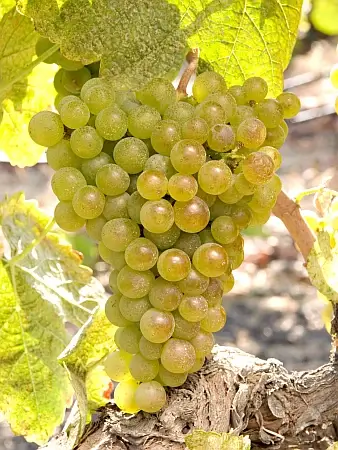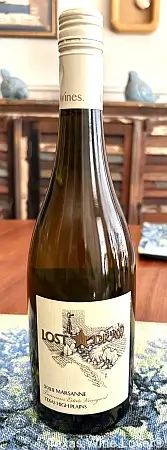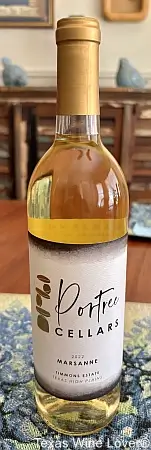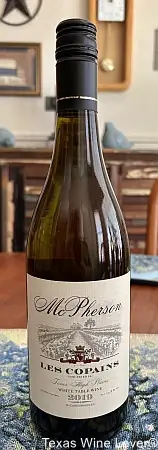
Marsanne Grapes on the Vine – Used with Permission, Tablas Creek Winery
This Texas Wine Lover post is about the lesser-known white grape variety, Marsanne (pronunciation mar-sahn), most commonly found in the northern sector of the Rhône Valley in southern France. It is often blended with Roussanne and sometimes Viognier. It is also grown in Switzerland (known as Ermitage blanc), Spain (known as Marsana), Australia, New Zealand, Canada, and the United States.
Much of the Rhône River Valley in southern France is comprised of steep to more gently rolling hills with sandy, rocky limestone, and clay soils, and a climate that tends to be dry with very little rain, hot with lots of summer sunshine, and plenty of windy days. Sort of sounds like parts of Texas, huh? Well, these characteristics for Marsanne, and the other key white Rhône grape varieties: Viognier, Roussanne, Picpoul Blanc, Grenache Blanc, and Rolle (Vermentino), are what make them prime candidates to grow in the wine regions of Texas that are typically hot, arid, and windy.
Marsanne almost certainly originated in the northern Rhône Valley, where it is a principal component of white wines from the Hermitage, Crozes-Hermitage, and Saint-Joseph AOCs. The Hermitage AOC is famous for intense, delicious, and long-lived red wines of Syrah, but the most common white variety there is Marsanne. In nearby Côte-Rôtie AOC, it was discovered long ago that adding white Viognier grapes (typically 4-8%) to Syrah fermentations not only improved aromas and mellowed tannins but also enhanced color characteristics. This unexpected phenomenon called “co-pigmentation” can also result when adding Marsanne to Syrah fermentations. Such is the wonder of wine chemistry.

Lost Draw Marsanne Timmons Estate Vineyard 2022 Texas High Plains
Note that for most French wines made with Marsanne, there will be no mention of the variety on the label, but rather the name of the AOC (wine region) will be shown, and it is left for you to figure out that Marsanne may be the variety in bottle or included in the blend. Thankfully, most of the rest of the wine world provides some indication on the front or back label that Marsanne is included.
Although Marsanne is important to the northern Rhône Valley region,s where it is often blended with Roussanne, it is somewhat surprisingly not permitted in the famous southern Rhône region of Châteauneuf-du-Pape AOC (while Roussanne is permitted). Marsanne is mostly made into dry wines, either varietal whites or a component of blends. But it can also be used to produce bright sparkling wines and delicious, sweeter wines, including late harvest dessert wines.
In other wine regions, Marsanne may take on different flavor characteristics, but it is fairly clear that the grape’s introduction can be traced back to its home in the French Rhône region of Hermitage. In Switzerland, the grape is often called Ermitage blanc. Syrah is the primary red grape in the Hermitage region, and with its introduction to Australia (where it is now most often called Shiraz) in the mid-1800s, along came Marsanne as an accompanying white grape.

Portree Cellars Marsanne Timmons Estate 2022 Texas High Plains
In British Columbia and Washington State, where Syrah has become a popular choice for red wines, plantings of Marsanne continue to increase as producers make varietal whites and often blends with Roussanne and Viognier. Marsanne has gained popularity in California as the Rhône Rangers movement introduced more Rhône Valley varieties and wines in the U.S.
Varietal Marsanne often shows aromas of spring peach blossoms, ripe peach and apricot fruit, and wildflower honey along with flavors of freestone peach, waxy honeycomb, toasted nuts, spiced pear, and quince. When treated with oak in production, Marsanne, like Roussanne, can take on creamy vanilla, fresh butter, baking spice, and smoky characteristics similar to those found in oaked Chardonnay. However, Marsanne blended with Viognier and/or Roussanne and fermented or aged in French oak barrels will produce a richness and complexity with less intrusive oak notes. Such blends have become popular alternatives to Chardonnay, especially in Texas, where not a lot of Chardonnay is currently grown. As Marsanne wines age, they take on a darker golden color, and flavors can become more complex and concentrated, even showing a slightly oily, honeyed texture.
Vintage conditions, especially warm vs. cool and wet vs. dry, can have a significant impact on aromas and flavors in Marsanne wines. This has been clearly noted in many U.S. regions like Washington, Oregon, Michigan, New Jersey, and Texas. Variations are also notable in places like New Zealand, Australia, Spain, and Switzerland, where climatic differences are common.
I recently tasted several Texas Marsanne varietal wines and blends containing Marsanne and have searched for information on other bottlings from Texas wineries. I encourage you to ask about Marsanne as a varietal wine or its use in a Rhône-style blend when visiting your favorite Texas tasting rooms.

McPherson Cellars Les Copains White Table Wine 2019 Texas High Plains
I did not find a lot of varietal bottlings of Marsanne, but have included notes on the ones I was able to taste.
Portree Cellars Marsanne Timmons Estate 2022 Texas High Plains AVA
- Grape(s): 100% Marsanne, sourced from Timmons Estate Vineyard near Brownfield in Terry County. Produced and bottled at Kerrville Hills Winery, Kerrville, TX, 13.3% ABV.
- This wine is a pale straw color with aromas of apricot, mandarin orange, and subtle vanilla; flavors on the palate include mandarin orange, green apple, apricot, white peach, quince, and beeswax. The finish is ripe and clean with a hint of oily, waxy character.
McPherson Cellars Marsanne 2021 TX High Plains
- Grape(s): Marsanne 100% sourced from Texas High Plains vineyards. Machine-harvested fruit was directly pressed and the juice fermented cool (56°F) in a stainless steel tank for 28 days; aged five months in a stainless steel tank; bottled @ 13.7% ABV, 0.3% RS (essentially dry).
- This varietal Marsanne shows aromas of spring peach blossoms, ripe peach, apricot, and wildflower honey along with flavors of freestone peach, waxy honeycomb, spiced pear, quince, and a hint of almonds. There is the distinctive waxy-concentrated mouthfeel one comes to expect in Marsanne. This bright, refreshing wine pairs well with avocado stuffed with chicken salad, white pizza pie with prosciutto and figs, baked poultry or pork, and honey-glazed peach tart for dessert.
Lost Draw Marsanne 2022 Texas High Plains
- Grape(s): Marsanne 100% sourced from Timmons Estate Vineyards, Brownfield, TX, Terry County. Bottled at 11.7% ABV.
- This medium-bodied wine offers a good texture in the mouth with moderate acidity that is well-balanced with the fruit. The initial quince and apple tartness leads into a smooth, slightly waxy/oily texture with ripe peach, golden apple, spiced pear, and citrus flavors on the palate.
Hilmy Cellars Marsanne 2022 Texas High Plains
- Grape(s): Marsanne 100% sourced from Canted County Vineyards near Lamesa in Dawson County, south of Lubbock. Grapes fermented cool in a stainless steel tank and aged in a stainless steel tank; bottled at 13.6% ABV.
- This medium-bodied wine offers aromas of peach blossoms, lemon grass, and citrus fruit with flavors of freestone peach, ripe pear, quince, and golden apple. There is balanced acidity with hints of those Marsanne characteristics of honeycomb on the finish. This wine won multiple awards for Hilmy Cellars.
I also have had the opportunity to taste the following blended bottlings that included Marsanne and have included tasting notes.
McPherson Cellars Les Copain White 2021 Texas High Plains
- This delightful wine is a blend of five Rhône grapes, including: Roussanne 46%, Viognier 20%, Marsanne 13%, Piquepoul Blanc 12%, and Grenache Blanc 9%, all sourced from High Plains vineyards.
- Les Copains in French means friends or partners, and Kim McPherson and Spenser Igo have created a stellar blend by partnering these five white Rhône grapes. These varieties have become well-established on the Texas High Plains and are a key part of the McPherson portfolio. This wine is fuller-bodied, slightly crisp, with aromas and flavors of peach, apple, citrus fruit, orange melon, and ripe pear. It is refreshing with well-balanced acidity at the finish.
McPherson Cellars Marsanne-Roussanne 2021 Texas High Plains
- This blend of Marsanne 60% and Roussanne 40% was sourced from Timmons Estate and Lahey Vineyards in Terry County. The cuvées were fermented cool in a stainless steel tank; aged in stainless steel; blended before bottling @ 13.1% ABV, 0.3% RS (essentially dry).
- Like Viognier, a Rhône Valley neighbor, both Marsanne and Roussanne grow well in Texas. Marsanne gives this blend delicate aromas of toasted almonds, a beeswax honeycomb fullness on the palate, and subtle citrus aromas and flavors. Roussanne offers a juicy mid-palate with notes of ripe peach and nectarine fruit, lemon drop candy, herbaceous tea-like character, and a hint of saltiness. The rich flavors and texture remind one of unoaked Chardonnay, and it pairs well with seafood and baked or grilled poultry and pork.
McPherson Cellars Marsanne-Roussanne 2022 Texas High Plains
- This blend of Marsanne 60% and Roussanne 40% was sourced from Timmons Estate and Lahey Vineyards in Terry County. The cuvées were fermented cool in a stainless steel tank; aged in stainless steel; blended before bottling @ 13.1% ABV, 0.3% RS (essentially dry).
- This blend saunters down the fine line between rich and racy. Abundant flavors of stone-fruit, honeysuckle, and warm lemon curd create ripeness and body, while fine minerality and acidity keep every sip in equilibrium. This is at once both lean and luscious, ideally suited to unctuous seafood dishes – think lobster risotto under a pile of snowy parmesan (YUM!).